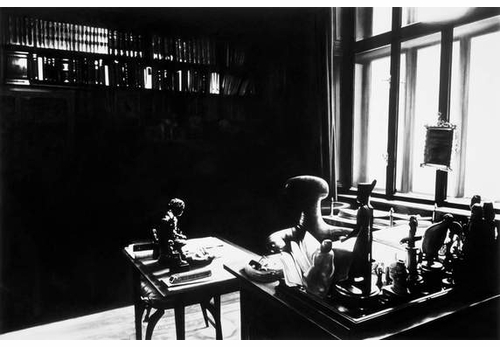ARTBOOK BLOGEventsStore NewsMuseum Stores of the MonthNew Title ReleasesStaff PicksImage GalleryBooks in the MediaExcerpts & EssaysArtbook InterviewsEx LibrisAt First SightThe Artbook 2023 Gift GuidesArtbook Featured Image ArchiveArtbook D.A.P. Events ArchiveDATE 4/30/2024 Danny Lyon at Photobook AustinDATE 4/30/2024 Rizzoli Bookstore presents Roger A. Deakins with James Ellis Deakins and Matthew Heineman on 'Byways'DATE 4/25/2024 Joshua Charow's 'Loft Law' documents the last of NYC's original artist loftsDATE 4/25/2024 Join us at Printed Matter's NY Art Book Fair 2024!DATE 4/25/2024 The Strand presents Joshua Charow in conversation with Wendy Goodman for the launch of 'Loft Law'DATE 4/24/2024 Bungee Space presents Set Margins’ 6-Book Launch and Get TogetherDATE 4/21/2024 Time & Space Limited presents "Memory as Various: Bernadette Mayer's 'Memory'"DATE 4/20/2024 Heads up on 4/20!DATE 4/18/2024 Howl! Arts/Howl! Archive presents Pyramid Pioneers with 'We Started a Nightclub' signingDATE 4/18/2024 A birthright and a legacy in Ivan McClellan's 'Eight Seconds: Black Rodeo Culture'DATE 4/14/2024 Vintage 'Audio Erotica' from Jonny TrunkDATE 4/13/2024 Unnameable Books presents "Reading from Bernadette Mayer's 'Memory'"DATE 4/13/2024 Artbook at Hauser & Wirth presents Heather McCalden and Cyrus Dunham launching 'The Observable Universe: An Investigation' | EXCERPTS & ESSAYSTHOMAS EVANS | DATE 2/16/2011Robert Longo: The Freud DrawingsIn June 1938, just a few days before Sigmund Freud and his family fled Vienna in the wake of Nazi Germany’s annexing of Austria, a young photographer named Edmund Engelman made a room-by-room photographic record of the home and offices in which Freud had lived and worked for 40 years—the offices and household in which the early dramas and birth pangs of psychoanalysis had been played out and theorised.Engelman worked stealthily, using only available light in order to avoid detection by the Nazis (who might otherwise have prevented the Freuds’ escape). Nonetheless, he managed to capture in loving detail the texture of the Freud family home: Freud’s massive collection of Egyptian and Greek sculpture, his textiles, his library (which had survived despite a Nazi directive to destroy it), photographs and memorabilia, the family rooms, the consulting room and of course the legendary couch upon which Freud’s patients such as the “Wolf Man” and the “Rat Man,” as well as artists and writers such as Gustav Mahler, Salvador Dali and H.G. Wells, had submitted their dreams and free associations to the great doctor. The Freud family moved to Hampstead, London, where Freud, then aged 82, spent the last year of his life; the following year, just after war broke out, Edmund Engelman relocated to New York, where he made a living as a consulting engineer in photographic technology. In 1976, Basic Books published Engelman’s Freud photographs, under the title Bergasse 19 (Freud’s address in Vienna). (This volume can still be found cheaply second-hand.)  Twenty years later, New York artist Robert Longo was given a used copy of Bergasse 19 by a friend. He writes, “The book, with its extraordinary photographs, sat around my studio and eventually insinuated itself into my consciousness, pushing me to take action.” The result was Longo’s The Freud Drawings, published by Kerber in 2002. This series comprises 30 large-scale charcoal drawings, which painstakingly either recreate individual photographs by Engelman, or amplify some particular detail, such as a door handle, the upholstery on a chair, an Egyptian figurine or Freud’s anthropomorphic bespoke swivel-chair.  In Longo’s precise rendering, the warm velour-esque textures and dramatic contrasts of the charcoal endow the image with a luminosity that is neither eerie nor comforting, but which certainly imparts to the viewer the cultural freight of the objects under scrutiny, the melancholy specter of loss and exile that attends them and an anxious consciousness of what tragic events were underway on the streets immediately beyond this seductive dwelling. (This latter aspect resembles the tension of interiors achieved and then expertly punctured by Bernardo Bertolucci in his 2003 film The Dreamers, in which a youthful ménage ŕ trois in the volatile Paris of May 1968 is disturbed in its indoor whirlpool of incest and narcissism by a brick thrown by a rioter from the streets below.) Longo’s drawings intensify Engelman’s record by affirming Freud’s household both as a home in which everything seems to have been lavished with an enduring love and care, and as a theatre heaped up with the props of significant cultural history. To Engelman’s work is added a historical consciousness that is vertiginous in scale—as well as the high degree of craft for which the artist is famed today. Kerber’s treatment of Longo’s cycle extends to fold-out plate sections (with excellent reproductions), a short statement by Longo and essays by Paul Auster, Werner Spies and Rainer Metzger, who neatly sums up the haunting character of Longo’s accomplishment in this simple formulation: “The aesthetic quality of [the] Freud Drawings lies in the fact that perception is complemented by knowledge.” |
